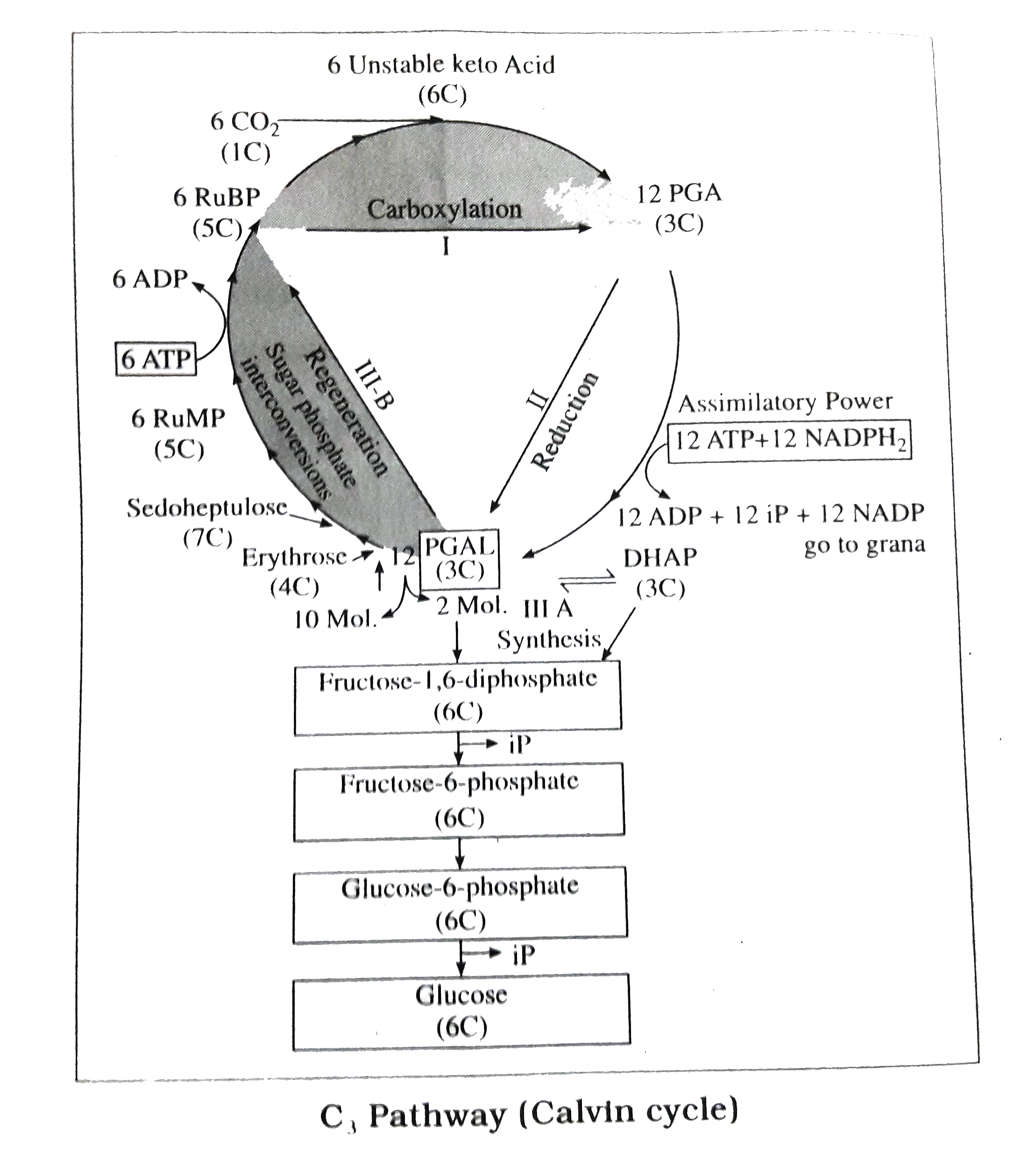What is dark reaction of photosynthesis ? Describe C3 pathway ?
Text Solution
1. Dark reaction of pohotosynthesis :
The lilght independent reaction of photosynthesis that occurs in stroma of chloroplast is called dark reaction of photosynthesis.
2. C3 Pathway :
(1) Dr Melvin Calvin in the year 1954 discovered the path of carbon in photosynthesis, i.e., sequence of reactions of CO2 fixation and synthesis of glucose from it using tracer technique, chromatography and autoradiography.
(2) The sequence of reactions of CO2 fixation into glucose is called Calvin cycle.
(3) Calvin and his co-worker Dr Bensen worked on Chlorella and Senedesmus (unicellular algae using C14 radioactive isotope of carbon) as tracer.
(4) The first product in Calvin cycle of photosynthesis is a 3-carbon compound, i.e., PGA (phosphoglyceric acid). Therefore, this pathway of photosynthesis is called C3 pathway.
(5) Calvin demonstrated and proved that the initial acceptor of carbon dioxide, i.e., RuBP is regenerated simultaneously with the synthesis of glucose. Calvin and his co-worker Dr Bensen where awarded a Nobel prize for this work in 1961.
(6) The various steps of Calvin cycle are as follows :
(i) Carboxylation : RuBP (Ribulose-1,-5 biphosphate) accepts atomospheric CO2 in the presence of the enzyme RuBP carboxylase (RuBISCO) and forms a 6-carbon unstable compound which soon splits into two molecules of 3-carbon compound called PGA (phosphoglyceric acid) in the presence of the same enzyme enzyme as shown under :
RuBP(5C)+CO2(1C)Mg+−−−−−→RuBISCOunstable compound (i)(6C)
Unstablecompound(6C)+H2OMg++−−−−−→RuBISCO2 molecules of 3-PGA(3C)
(ii) Reduction of PGA : The PGA thus formed undergoes photo-phosphorylation using ATP to form 1. 3-disphosphoglyceric acid which is reduced to PGAL (phospho-glyceraldehyde) by NADPH2 with the release of iP (inorganic phosphate). The reduction of PGA to PGAL can be summarized as follows:
3PGA+ATP→1, 3 diphospohoglyceric acid +ADP
1, 3 diphosphoglyceric acid +NADPH2→3PGAL+NADP+iP
Some molecules of PGAL undergo isomerization and form DHAP (dihydroxyacetone phosphate). This isomerization reaction is catalysed by the enzyme triose phosphate isomerase.

(iii) Synthesis of sugar : For the synthesis of one molecule of glucose six molecules of RuBP and six molecules of CO2 or 6 turns of Calvin cycle ar required. This shows that six turns of Calvin cycle are required for the synthesis of one molecule of glucose. Out of 12 molecules 2 molecules 2 molecules i.e., 1/6 part of PAGAL are utilized for the synthesis of glucose. One molecule of PGAL and one molcecule of DHAP combine with each other to form one molecule of fructose 1, 6-diphosphate as shown below :
3PGAL(3C)+DHAP(3C)→Fructose 1, 6-diphosphate(6C)
Fructose 1, 6-diphosphate undergoes dephosphorylation to form fgructose-6-phosphate which on isomerization forms glucose-6-phosphate. Glucose-6-phosphate undergoes dephosphorylation to form glucose. Glucose thus formed is either utilized or stored as starch.
(iv) Regeneration of RuBP : RuBP is regenerated through biochemical reactions called sugar phosphate interconversions. All the intermediate compounds, for example, erythrose-4-phosphate, xylulose-5-phosphate, ribose-5-phosphate, sedoheptulose-7-phosphate, etc. that arew formed during these reactions are sugar phosphates. Out of 12 molecules of PGAL 10 molecules are utilized for the regeneration of 6 molecules of RuMP (ribulose monophosphate) which on pohosphorylation form RuBP as shown below :
12 PGAL → 6 RuMP ...(1)
6 RuMP+6 ATP→RuBP ...(2)
Thus RuBP which is necessary for the reduction of CO2 is regenerated to keep the process going.
|
Updated on:21/07/2023
Related Playlists
- BOOK - NAVNEET PUBLICATION - MAHARASHTRA BOARDCHAPTER - LONG ANSWER QUESTIONSEXERCISE - Respiration4videos
LONG ANSWER QUESTIONS
- BOOK - NAVNEET PUBLICATION - MAHARASHTRA BOARDCHAPTER - LONG ANSWER QUESTIONSEXERCISE - Reproduction in Plants9videos
LONG ANSWER QUESTIONS
- BOOK - NAVNEET PUBLICATION - MAHARASHTRA BOARDCHAPTER - LONG ANSWER QUESTIONSEXERCISE - Gene : Its Nature, Expression and Regulation6videos
LONG ANSWER QUESTIONS
- BOOK - NAVNEET PUBLICATION - MAHARASHTRA BOARDCHAPTER - GIVE REASONS EXERCISE - Organisms and Environment - II2videos
GIVE REASONS
- BOOK - NAVNEET PUBLICATION - MAHARASHTRA BOARDCHAPTER - MATCH THE COLUMNS/MATCH THE PAIRS/COMPLETE THE TABLEEXERCISE - Chapter 19 : Organisms and Environment - II3videos
MATCH THE COLUMNS/MATCH THE PAIRS/COMPLETE THE TABLE
Similar Questions
What is dark reaction in photosynthesis ? Describe C3 Pathway.
View SolutionDark reaction of photosynthesis is
View SolutionDark reaction of photosynthesis is
View SolutionDark reaction of photosynthesis is
View SolutionDuring dark reaction of photosynthesis
View SolutionDuring dark reaction of photosynthesis
View SolutionDark reaction of photosynthesis occurs in
View SolutionDark reactions of photosynthesis occur in
View SolutionDark reaction of photosynthesis occurs in
View SolutionDark reactions of photosynthesis occur in
View Solution

